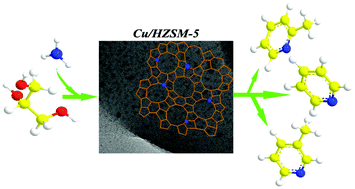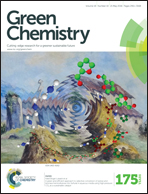A study on the conversion of glycerol to pyridine bases over Cu/HZSM-5 catalysts†
Abstract
A catalyst of 4.6% Cu supported on HZSM-5 with Si/Al of 38 [4.6% Cu/HZSM-5(38)] was prepared in this work. Pyridine bases including pyridine and 2- and 3-picoline, were obtained over this catalyst from glycerol and ammonia. The parameters influencing the catalyst performance were studied thoroughly. An optimized process for the reaction of glycerol with ammonia to form the pyridine bases was also obtained. Under the optimized conditions, which include a reaction temperature of 520 °C, atmospheric pressure with an ammonia/glycerol molar ratio of 7 : 1, and a GHSV of 300 h−1, the total carbon yield of the pyridine bases was nearly 42.8%. Characterization results from the IR of the adsorbed pyridine indicated that the doping of copper into HZSM-5(38) led to significant changes in the Lewis/Brønsted ratio. An appropriate proportion of the two types of acid sites is important to determine the total selectivity of pyridine bases. XRD analysis showed that copper was initially present in the CuO state and then converted into elemental Cu reduced by H2 generated in situ in the catalytic run. TEM and nitrogen adsorption–desorption characterization revealed that the catalyst deactivation was mainly caused by carbonaceous deposits on the catalyst. The catalyst can be regenerated online by blowing air into the reactor at 550 °C for 6 h. The slight decrease of the activity of the regenerated 4.6% Cu/HZSM-5(38) compared with that of the fresh one could be ascribed to the partial sintering of copper particles and dealumination of the catalyst in the catalytic run.


 Please wait while we load your content...
Please wait while we load your content...